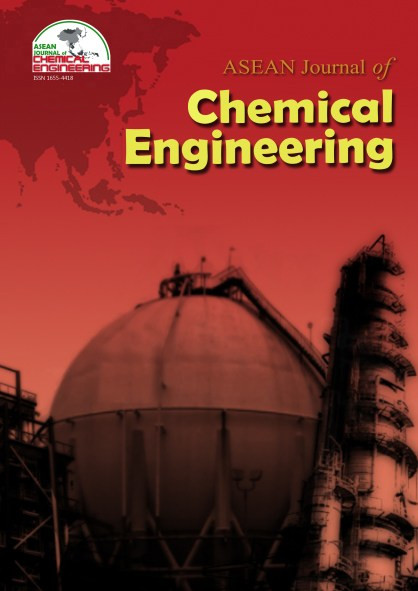Process Optimization of Carbon Dioxide Adsorption using Nitrogen-Functionalized Graphene Oxide via Response Surface Methodology Approach
Abstract
This paper presents a response surface methodology approach in the optimization of the carbon dioxide temperature-programmed adsorption process using a new material referred as nitrogen-functionalized graphene oxide. This material was synthesized by loading nitrogen groups to graphene oxide using aqueous ammonia in supercritical condition. Later on, it was utilized as a sorbent for carbon dioxide adsorption. This process was optimized by implementing a response surface methodology coupled with a Box- Behnken design for the effects of three factors: adsorption temperature, carbon dioxide flow rate, and the amount of adsorbent. In analyzing the response surface, a model equation was generated based on the experimental data by regression analysis. This model equation was then utilized to predict optimum values of response. Furthermore, response optimizer was also conducted in identifying factor combination settings that jointly optimize the best response.
References
2. Baldovino, F. H. B., Quitain, A. T., Dugos, N. P., Roces, S. A., Koinuma, M., Yuasa, M., & Kida, T. (2017). Synthesis and characterization of nitrogen- functionalized graphene oxide in high- temperature and high-pressure ammonia. RSC Adv., 7, 3852. doi:10.1039/c6ra90131j.
3. Baldovino, F. H. B., Quitain, A. T., Dugos, N. P., and Roces, S. A. (2017). Ammonia surface-functionalized nanomaterials for carbon dioxide capture. De La Salle University. Ph.D. Thesis.
4. Choi, A. E., Roces, S., Dugos, N., Futalan, C. M., Lin, S., & Wan, M. (2014). Optimization of ultrasound-assisted oxidative desulfurization of model sulfur compounds using commercial ferrate (VI). Journal of the Taiwan Institute of Chemical Engineers, 45(6), 2935-2942. doi:10.1016/j.jtice.2014.08.003.
5. Diao, Y., Zheng, X., He, B., Chen, C., & Xu, X. (2004). Experimental study on capturing CO2 greenhouse gas by ammonia scrubbing. Energy Conversion and Management, 45(13- 14), 2283-2296. doi:10.1016/j.enconman.2003.10.011.
6. Jilvero, H., Mathisen, A., Eldrup, N., Normann, F., Johnsson, F., Müller, G. I., & Melaaen, M. C. (2014). Techno- economic Analysis of Carbon Capture at an Aluminum Production Plant – Comparison of Post-combustion Capture Using MEA and Ammonia. Energy Procedia, 63, 6590-6601. doi:10.1016/j.egypro.2014.11.695.
7. Körbahti, B. K., & Rauf, M. (2008). Response surface methodology (RSM) analysis of photoinduced decoloration of toludine blue. Chemical Engineering Journal, 136(1), 25-30. doi:10.1016/j.cej.2007.03.007.
8. Lu, A., Hao, G., & Zhang, X. (2014). Porous Carbons for Carbon Dioxide Capture. Green Chemistry and Sustainable Technology, 15-77.
9. Sayari, A., Belmabkhout, Y., & Serna- Guerrero, R. (2011). Flue gas treatment via CO2 adsorption. Chemical Engineering Journal, 171(3), 760-774.
10. Serna-Guerrero, R., Belmabkhout, Y., & Sayari, A. (2010). Modeling CO2 adsorption on amine-functionalized mesoporous silica: 1. A semi-empirical equilibrium model. Chemical Engineering Journal, 161(1-2), 173-181. doi:10.1016/j.cej.2010.04.024.
11. Zhao, B., Su, Y., Tao, W., Li, L., & Peng, Y. (2012). Post-combustion CO2 capture by aqueous ammonia: A state-of-the- art review. International Journal of Greenhouse Gas Control, 9, 355-371. doi:10.1016/j.ijggc.2012.05.006.
Copyright holder for articles is ASEAN Journal of Chemical Engineering. Articles published in ASEAN J. Chem. Eng. are distributed under a Creative Commons Attribution-NonCommercial 4.0 International (CC BY-NC 4.0) license.
Authors agree to transfer all copyright rights in and to the above work to the ASEAN Journal of Chemical Engineering Editorial Board so that the Editorial Board shall have the right to publish the work for non-profit use in any media or form. In return, authors retain: (1) all proprietary rights other than copyright; (2) re-use of all or part of the above paper in their other work; (3) right to reproduce or authorize others to reproduce the above paper for authors’ personal use or for company use if the source and the journal copyright notice is indicated, and if the reproduction is not made for the purpose of sale.



